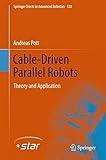Cable-Driven Parallel Robots [electronic resource] : Theory and Application / by Andreas Pott.
By: Pott, Andreas [author.] .
.
Contributor(s): SpringerLink (Online service) .
.
Material type:  BookSeries: Springer Tracts in Advanced Robotics: 120Publisher: Cham : Springer International Publishing : Imprint: Springer, 2018Edition: 1st ed. 2018.Description: XXIV, 465 p. 190 illus., 130 illus. in color. online resource.Content type: text Media type: computer Carrier type: online resourceISBN: 9783319761381.Subject(s): Control engineering
BookSeries: Springer Tracts in Advanced Robotics: 120Publisher: Cham : Springer International Publishing : Imprint: Springer, 2018Edition: 1st ed. 2018.Description: XXIV, 465 p. 190 illus., 130 illus. in color. online resource.Content type: text Media type: computer Carrier type: online resourceISBN: 9783319761381.Subject(s): Control engineeringIntroduction -- Classification and Architecture -- Geometric and Static Foundations -- Kinematic Codes -- Workspace -- Dynamics -- Kinematics with Nonstandard Cable Models -- Design -- Practice.
Cable-driven parallel robots are a new kind of lightweight manipulators with excellent scalability in terms of size, payload, and dynamics capacities. For the first time, a comprehensive compendium is presented of the field of cable-driven parallel robots. A thorough theory of cable robots is setup leading the reader from first principles to the latest results in research. The main topics covered in the book are classification, terminology, and fields of application for cable-driven parallel robots. The geometric foundation of the standard cable model is introduced followed by statics, force distribution, and stiffness. Inverse and forward kinematics are addressed by elaborating efficient algorithms. Furthermore, the workspace is introduced and different algorithms are detailed. The book contains the dynamic equations as well as simulation models with applicable parameters. Advanced cable models are described taking into account pulleys, elastic cables, and sagging cables. For practitioner, a descriptive design method is stated including methodology, parameter synthesis, construction design, component selection, and calibration. Rich examples are presented by means of simulation results from sample robots as well as experimental validation on reference demonstrators. The book contains a representative overview of reference demonstrator system. Tables with physical parameters for geometry, cable properties, and robot parameterizations support case studies and are valuable references for building custom cable robots. For scientist, the book provides the starting point to address new scientific challenges as open problems are named and a commented review of the literature on cable robot with more than 500 references are given.


There are no comments for this item.